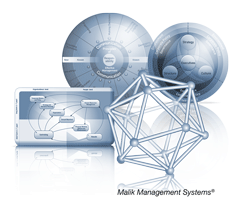Reference example reorganization: supplier
From the Malik practice of big restructures
If the “ship runs aground…”
Leadership with innovative, high-performance methods
The new organization for the new strategy
In a globally operating company in the supplier industry, with around 10.000 employees, the promising strategic potential for market success was to be realized quickly and consistently. To that end, the executive board decided, among other things, to make a fundamental change in the organizational structure which directly affected around 2.500 employees worldwide.
The brilliant results and a new way of functioning
It was possible to carry out the first Syntegration® to determine the basic structure just two weeks after the executive board’s decision. The second Syntegration to determine the micro-structure of the new organization took place just eight weeks later.
The key results of the Syntegration method were:
» Saving the company from a completely hopeless situation of failure brought about by conventional methods
» A fundamentally new organizational structure
» Achievement of universal consensus for the new solutions
» Transformation from resignation to a spirit of optimism and a will to implement change
» Ensuring the new procedures
» New tasks for each of the 30 key individuals at the highest levels
» Length of time for the transformation: twelve weeks
» Number of working days required for the turnaround for executives: ten days
» The transformation’s length of impact: sustainably unlimited
» Costs: 1.5 percent of the previously failed process
» Satisfaction: from 100 percent negative with the old process to 95 percent positive with Syntegration
Failure of conventional processes
The organization’s primary management criterion in place up to that point was to be switched from the region to the business unit. Additional organizational units for the development of new business had to be anchored in the new structure. This required making a major intervention into previously established procedures, as well as in the “vested organizational rights” and the corporate culture. Before conducting the Syntegration, the process was initiated internally with conventional methods.
During numerous workshops that became more and more difficult to coordinate, various organizational alternatives were discussed endlessly, which meant the work dragged on for months. In spite of this great effort, it was not possible to get the key managers to agree on one solution. The chances of arriving at an acceptable compromise solution thus dwindled. Time became a pressing matter, since the competition was also very active in the market. Resignation began to spread, as well as the fear that one might have wasted opportunities. It became clear that the complexity of the problem had been seriously underestimated, and that the chosen procedure was ineffective – although it had appeared to be tried and tested. As a result, the corporate culture criteria were conceivably poor. Motivation and morale approached the zero point, the willingness to change was at an all-time low and management had lost a considerable amount of credibility and trust …
In this delicate situation the executive board made the unusually bold decision to radically change the approach, and it resolved to conduct a Malik Syntegration. The goal of that was to find and define a new organizational structure as quickly as possible.
Two Syntegrations at the top level
With that in mind, two Syntegrations were carried out. The first one had the goal of finding a new structure. A second Syntegration was used for the enormously demanding changes related to the personal tasks of top executives, which were required in order for the new structure to function reliably. For that purpose, the company’s 30 most important executives worldwide were asked to make up for lost time as part of a jointly orchestrated tour de force that made use of Syntegration and lasted 3.5 days. The group of 30 top executives included all those at the highest level who believed that they would lose out in terms of power and influence over the course of the reorganization – a risk that was taken purposefully because one wanted to hold on to those executives. The crucial point, among other things, was the hope that it would be possible to speak openly with the approximately 30 top executives about the organization of the company, the size of which had been estimated to be about 10.000 employees. As it turned out, the conventional processes were entirely unsuitable for this.
The participants experienced Syntegration in extremely positive terms. Their degree of satisfaction was at more than 90 percent. The previously inhibiting patterns were broken and new, effective patterns came about. The Syntegrations were not “social events,” nor were they laborious, time-consuming workshop meetings. Rather, during each phase they involved well-targeted and productive tasks without the slightest bit of idle time. For the participants, the Syntegration opened up a new dimension in terms of coming up with solutions together and experiencing and understanding a completely new quality of communication. During this critical situation, top management displayed competent leadership, thereby regaining credibility and trust.
With the new social methodology of Syntegration one can carry out reorganizing projects much faster and more effectively than with any conventional method. Restructuring goals are achieved more rapidly and smoothly, thanks to the leverage effect of the Syntegration processes. Syntegration achieves in days and weeks what conventional methods take months to do. The usual damage to the corporate culture does not occur with Syntegration.
A complete practical example can be found in the Malik Letter Syntegration for Reorganization (04/11), page 42f.
This result was primarily achieved based on our core method, the Malik Syntegration®. We have solved the same challenge for several business segments as retail, information technology, services, production, energy, finance, etc.
